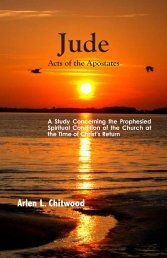Signs in John's Gospel - The Lamp Broadcast
Signs in John's Gospel - The Lamp Broadcast
Signs in John's Gospel - The Lamp Broadcast
Create successful ePaper yourself
Turn your PDF publications into a flip-book with our unique Google optimized e-Paper software.
Except a Man… (II) 95<br />
iz<strong>in</strong>g burial follow<strong>in</strong>g death (taken down <strong>in</strong>to the place of death)<br />
and raised up out of the Sea, symboliz<strong>in</strong>g resurrection (raised up<br />
out of the place of death) and placed on the eastern banks of the<br />
Sea (Ex. 12-15).<br />
<strong>The</strong>y stood on the eastern banks of the Sea through supernatural<br />
means, where<strong>in</strong> resurrection power was exhibited. And they<br />
stood <strong>in</strong> this position with a view to an <strong>in</strong>heritance <strong>in</strong> another land,<br />
with<strong>in</strong> a theocracy.<br />
<strong>The</strong> Israelites, pass<strong>in</strong>g through the Sea, had gone down <strong>in</strong>to<br />
the place of death. Only the dead are to be buried, and the death<br />
of the firstborn had just occurred. Thus, a burial must also occur.<br />
But beyond burial, with a vicarious death of the firstborn, there<br />
must also be a resurrection.<br />
<strong>The</strong> Israelites, follow<strong>in</strong>g the death of the firstborn, possessed<br />
spiritual life. Thus, they had to be raised from the place of death<br />
to walk “<strong>in</strong> newness of life” — someth<strong>in</strong>g hav<strong>in</strong>g to do with the<br />
spiritual man alone, for this resurrection had noth<strong>in</strong>g to do with<br />
the man of flesh. He was to be left <strong>in</strong> the place of death.<br />
This is pictured dur<strong>in</strong>g the present dispensation through the<br />
act of baptism. A person (a Christian), hav<strong>in</strong>g experienced the<br />
death of the firstborn vicariously (through the blood of the Paschal<br />
Lamb, Who died <strong>in</strong> his stead), is placed down <strong>in</strong> the waters. He<br />
then, with<strong>in</strong> the symbolism <strong>in</strong>volved, f<strong>in</strong>ds himself <strong>in</strong> the place of<br />
death, beneath the waters.<br />
But, because the One provid<strong>in</strong>g the vicarious death conquered<br />
death, the Christian can be removed from the waters and f<strong>in</strong>d<br />
himself <strong>in</strong> the position of hav<strong>in</strong>g been raised with Christ (Col. 2:12;<br />
3:1ff).<br />
And <strong>in</strong> this position — wrought through supernatural, resurrection<br />
power — the Christian is to walk “<strong>in</strong> newness of life” (Rom. 6:4),<br />
with a view to an <strong>in</strong>heritance <strong>in</strong> another land, with<strong>in</strong> a theocracy.<br />
It is go<strong>in</strong>g down <strong>in</strong>to the place of death because of the death of<br />
the firstborn, and it is ris<strong>in</strong>g from this place, as Christ was raised,<br />
because the person possesses spiritual life. And this ris<strong>in</strong>g has to<br />
do with the spiritual man alone, for, aga<strong>in</strong>, this resurrection has<br />
noth<strong>in</strong>g to do with the man of flesh. He is to be left <strong>in</strong> the place<br />
of death.



